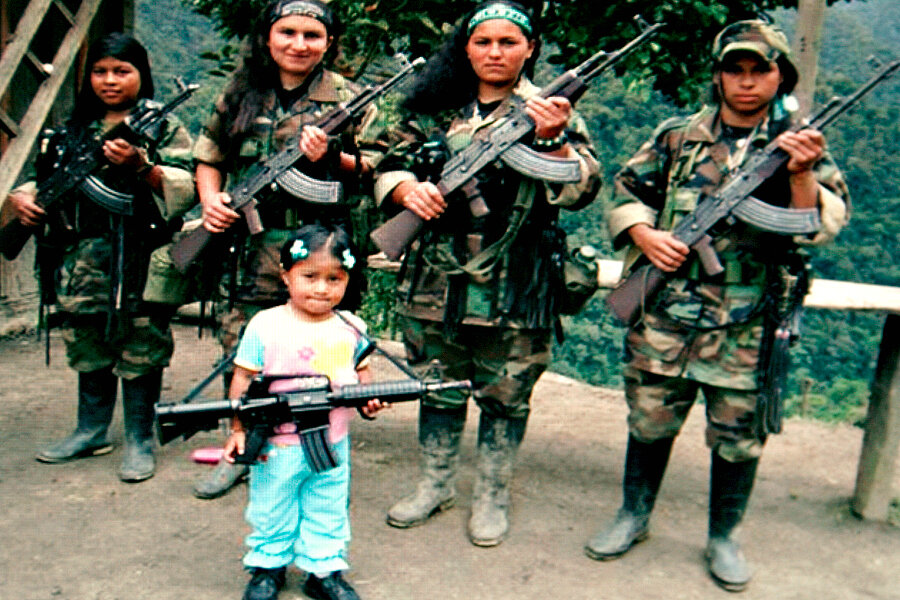Ex-child soldiers in Colombia face their tormentors
| BOGOTá, Colombia
When Carlos and five other teenagers arrived at a remote farm in Colombia's eastern plains where they had been promised work as laborers, they were horrified to be met by armed men who blindfolded them and ordered them to stand in line.
The farm was, in fact, a training camp run by a now defunct umbrella organization of paramilitary groups set up to fight the left-wing guerrillas of the Revolutionary Armed Forces of Colombia (FARC).
Here Carlos, 15, spent the next two years as a child soldier of the United Self-Defense Forces of Colombia (AUC), armed, trained, and forced to fight on the front line of the civil war against the FARC.
"We were given assault rifles that were taller than some of us," said Carlos, who declined to give his surname, recalling his forced recruitment 12 years ago.
"People went missing, were tortured and killed at the camp. I lost my innocence and youth there. The rain, sun, wild animals made the training very hard. The commanders didn't care about us, if we fell ill or died. I would cry when I was on night guard duty alone," Carlos told the Thomson Reuters Foundation.
Colombia has been wracked by drug-fueled civil war for 50 years, and all the illegal armed groups – rebels and right-wing paramilitaries, along with criminal gangs – have forcibly recruited teenagers or taken on underage volunteers, especially in remote rural areas with few job opportunities.
The groups use children as messengers, informants, cooks, and porters. FARC rebels also train them to use weapons, grenades, and mortars and to plant homemade landmines.
Girls are used as sex slaves and undergo forced abortions, according to the government and rights groups.
Between 2002 and 2014, half of the 17,345 FARC fighters who left the group – some escaped, others were captured by government troops– were under 18 when they joined, according to the defense ministry.
No more child soldiers?
Commanders of the FARC, Colombia's largest rebel group, recently announced that they would stop recruiting fighters younger than 17.
But the 8,000-strong FARC, which has been holding peace talks in Cuba with the government for two years, did not commit itself to releasing child fighters already in its ranks.
Carlos handed over his weapon and turned himself in when he stumbled across an armed forces roadblock in 2005.
A decade later Carlos, now 27, says a recent meeting with the paramilitary warlord who had him seized has finally enabled him to put behind him the trauma of two years as a fighter.
The meeting, part of government efforts to forge reconciliation and lay the groundwork for peace, brought him face to face with Orlando Villa, now serving a seven-year jail term for war crimes including forcibly recruiting 73 children into his paramilitary group.
Public apology
"These recruited minors never wanted to be part of this war. They were totally tricked. For this, I ask for forgiveness," said Villa, who was let out of prison for several hours to deliver his apology to Carlos and six other ex-child combatants, in the presence of government officials at the offices of the Organization of American States in Bogotá.
"I harmed these youngsters, their families, and their entire communities. They lost the chance of becoming other people. I could have seen to it that they did not suffer harm but I didn't," said Villa, flanked by three heavily armed prison guards.
His audience listened, still and silent. Carlos looked intently at Villa, while the other former child fighters avoided Villa's gaze and placed their hands over their faces.
"When he began to speak, my heart started racing," Carlos said afterwards.
"It felt like being back at the camp on the day I was recruited. I decided to forgive him once he apologized. I think he recognized the wrong he had committed. I later shook his hand and hugged him."
Hundreds of similar public and private acts of reconciliation have taken place to honor the victims of Latin America's longest-running war, including meetings between civilian victims and FARC chiefs at the Cuba peace talks.
"Public apology ceremonies are an important step towards reconciliation because the perpetrators recognize their responsibility for the damage they've caused, and it brings dignity to victims and contributes to their healing," Maria Eugenia Morales, a senior official at the government's victims' unit, told the Thomson Reuters Foundation.
The official war victims' register lists 7 million Colombians, nearly 85 percent of whom have been driven from their homes, as well as victims of sexual violence and landmines, and child fighters.
"Not all victims want to forgive," Morales said.
"Some widows and parents of missing people say they won't forgive until they find out what happened to their sons, daughters, and husbands, and where their bodies are."
(Reporting By Anastasia Moloney; Editing by Tim Pearce)
• This article originally appeared at Thomson Reuters Foundation, a source of news, information, and connections for action. It provides programs that trigger change, empower people, and offer concrete solutions.





